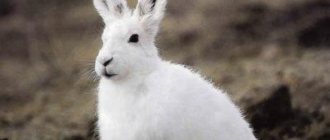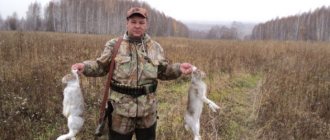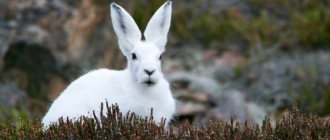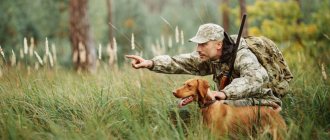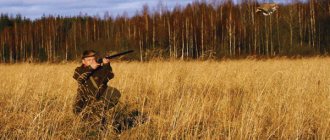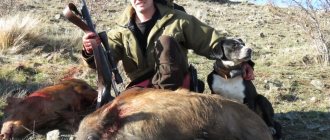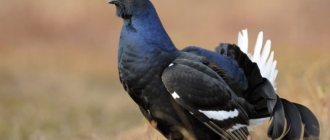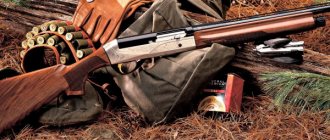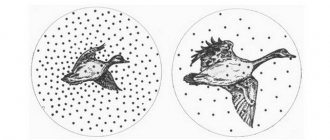Traces of hare and hare
As a rule, hunting for fresh whitebait is carried out for the brown hare, and there are several reasons for this. Firstly, the white color of the hare makes it almost invisible to the hunter, and secondly, this type of hares confuses tracks very well, and it is sometimes difficult to determine its location. Even if you find a place where an animal spends its day, the likelihood that it will go unnoticed is very high.
In this regard, if you live in an area where both types of hare live, it is very important to be able to distinguish them by their malik. The key difference is that the hare's paws are slightly rounder and wider than those of the hare. Wider paws help the animal move faster on loose snow. The paw prints of the hare are more oval and long, as they are on average larger than their relatives.
Traces of a hare and a hare in comparison
And now - tips for beginners
The most frequently asked question on hunting forums is how to shoot a hare. Everything is quite simple: you need to aim at the side runner with anticipation. At a distance of 10 meters, this is one body, at twenty meters you need to aim 1.7 bodies ahead, and at thirty meters, three bodies ahead. If the animal runs towards the hunter, you need to aim at the front legs. If you aim at the head or even the chest, the shot will go above the head and only hit the tail. If the animal leaves, then you need to aim at the ears.
If the animal leaves, then you need to aim for the ears
If a wounded animal is taken, it must be finished off. The fastest way is to step on the neck with your foot and press hard. A fracture of the cervical vertebrae means instant death. Never finish off an animal with a butt. A spontaneous discharge may occur or the butt itself may split.
Lead when shooting a running hare
A hunted hare may bleed for quite a long time. To do this, you should always take a thick plastic bag with you, but you don’t need to wrap the trophy very tightly - the game will “suffocate” and lose its presentation.
Rule for shooting a hare
When cutting, the greatest attention should be paid to the liver - if bile spills, the meat will be bitter and almost spoiled. The gallbladder is located on the inside of the liver in a small dark green leathery sac. It is advisable to soak hare meat well for 6–12 hours before cooking.
Time and place of hunting
It is worth noting right away that it is very difficult even for an experienced hunter to determine when the animal was in place if there had been no powder or strong wind for a long time. You can trail all day, but you will never see the animal. Therefore, in order for the hunt to be successful, it is worth going out immediately after a good snowfall or strong wind, which the old malik was able to sweep away.
When hunting in fresh snow, be prepared for a lot of walking. Therefore, if the snow level is high, you need to prepare hunting skis in advance. Because traveling on skis is not only faster, but also easier.
You need to go hunting as soon as possible after a snowfall. If it snowed at night, then morning is the most suitable time. The fact is that if you go out after lunch, you may simply not have time to find the trail and track down the “oblique” one, since the winter day is very short, and you need to cover long distances. Also, after a snowfall, as a rule, the weather remains warm, causing the hare to lie down less sensitively than usual and to allow the hunter closer to him.
A few rabbit secrets
Everyone knows what a hare looks like. In total, there are about 30 species of hares in nature. Although there has been scientific debate on this issue for a long time, both rabbits and pikas are classified as hares, and thus there are 45 wild species.
Difference between hare and rabbit
Representatives of the hare family live everywhere except Antarctica, and in Australia there are no native animals, but domestic rabbits, introduced a little over 100 years ago, have gone wild and have become a real scourge on this continent. There, hunting for them is open all year round and without restrictions.
Brown hare in winter Rabbits in Australia
Tracking process
The search for “oblique” should begin with the places where it is fattened. They feed near fruit trees, winter crops, and grain residues in the fields. The fact that there was an animal at the site of the fattening will be evidenced by many traces left in the snow.
When you have found such a place, you should go around it in a circle and find the hare’s exit point. This place will definitely be there, since the animal never spends its day in feeding areas. You need to follow the trail a little to the side, and do not trample the trail, since the hare, in order to confuse the tracks, can make a circle and return to its original place. In most cases, animals confuse the trails in the following ways:
- Makes loops in the snow of different sizes.
- Can return to the path several times and change its direction.
- It may not take a day to return, following in the footsteps of other hares.
In the process of tracking the “oblique”, you may encounter situations where the hare’s tracks intersect. There is a possibility of two different individuals passing through, but most likely, such a loop was performed by the same animal in order to confuse the tracks. If you find such loops, do not rush to move to a new path, as the hare may make a skid (jump to the side).
Loop Crossing Example
It is important to understand that the further you are from the site of the “oblique” fat, the more attentive and careful you should be. As already written above, you need to walk a little to the side, as you may not notice the beast’s discount to the side. In the process of tracking, every hunter should know that during the day, the hare lies down with its muzzle in the direction from which the wind blows.
It is important to remember that the hare lies down a little away from its path. If you walk along the path and look only straight ahead, most likely you will not meet the “slanting” one.
Peculiarities
There are certain features of how to catch a hare with a noose. It is necessary to tie the loops to a thin movable tree, then the animal will not break loose and run away, but will remain in the loop almost undamaged
If there is a lift on the loop, it is important that the hare is choked quickly so that he does not break the loop
The noose must be placed in such a way that the animal's head gets caught in it. Therefore, it is good to do this over a fallen tree trunk.
Attention! Hunting with snares is prohibited on the territory of the Russian Federation; this information is provided only for the purpose of familiarizing yourself with how not to hunt. Follow the hunting rules and laws of your country
Malik and its types
The success of hunting by tracking in the snow directly depends on how correctly you can read the tracks of the animal. Let's look at what types of tracks are and what they can tell a hunter.
What do the tracks of a hare look like in the snow?
Estimate or discount
These traces are distinguished by a large distance from each other and are located at a large angle to the original trace. As a rule, the hare leaves trailing marks before going to bed for the day, and their number ranges from 1 to 5. The key feature of sweeping tracks can be considered that the prints of the front paws are located together.
Fatty
Fat marks can be called an indicator of where the hare was fattened. As a rule, there are many of them at the feeding site and they cover a certain area. Fat tracks differ from normal ones in that their paw prints are close to each other and often merge. It is from the place where fatty traces are found that the tracking of the animal in winter begins.
Racing
These tracks indicate that the hare was scared away from its resting place. Beginning hunters can easily confuse rutting marks with discount marks, as they look almost like sweep marks. The key differences are that their number is usually greater than 5, and the prints of the hare's front paws are much closer to the prints of the previous jump than the subsequent one. In other words, during the rutting run the animal throws its hind legs forward more strongly.
In the Uzerka
It is held in late autumn and early winter. The hunter walks in search of prey and when he sees a hare, he fires a shot. But this hunt is effective only when the hare’s skin differs from its surroundings.
It is best to hunt when the weather is warm without frost, the soft soil muffles footsteps.
Whites hide under low fir trees, and sometimes they just lie in plain sight.
Uzerka hunting is best done with two assistants. They will walk along the sides at a distance of 30 steps, and look out for hares. When game is detected, team members will let the hunter know with a whistle. Such a hunt is carried out depending on the weather, sometimes it can last ten days.
Where is the bed located?
We have already written above that when walking along the small road you need to be extremely careful and look around, but what places should you pay special attention to? First of all, the animal looks for shelter near low bushes, fallen young spruce trees, etc. If there is no vegetation nearby where it can hide, the hare can simply lie down in a field. This will be indicated by a small hill of snow.
If you find an animal, but did not have time to fire a shot or it simply disappeared, there is no need to continue the pursuit, since the “squint” can run several kilometers before lying down again. In this case, it is better to look for traces of another hare. When you fired a shot, but are not sure that you hit it, you need to follow the trail for 10-20 minutes. If drops of blood are found on the trail, it is recommended to continue the pursuit. If no traces of blood were found in the snow, you can safely start searching for another animal. And at the end of the article, we invite you to watch a video of hunting a hare by following its tracks.
Catching wild rabbits
It is worth noting that in the process of catching wild rabbits you cannot do without a well-made trap. The simplest options in this regard are using snares and a wolf pit.
Hunting a wild rabbit
A standard snare is made of durable brass wire. In the lower part it is folded into a tightening loop, and the upper part is tied to the trunk of a tree or a powerful branch. The following points are taken into account:
- The loop must be placed in natural arches (snags, young trees with branches, intersections of large shrub trunks) located on rabbit trails.
- If there are no natural arches, you can carefully trim the branches of an ordinary tree, making such an obstacle yourself. To install the snare, it is enough to cut off 30 cm.
- The loop should be located at a height of 10-15 cm from the ground.
- It is better to carefully place some branches on the sides of the path to prevent the possibility of walking around.
It’s even easier to make another rabbit trap with your own hands. The wolf pit is made as follows:
Read also: Breeds of rabbits: fur and down (with photos and names)
Attention! When installing snares and wolf pits, do not check them or adjust them too often. During such procedures, a human odor may remain, which will alert and scare away animals.
Catching a pet or wild rabbits requires some skill. But in any case, these points will significantly increase the chances of success. Moreover, the skills of catching wild rabbits can also be useful if you plan to breed such animals at home. Today this is a fairly profitable area of livestock farming.
